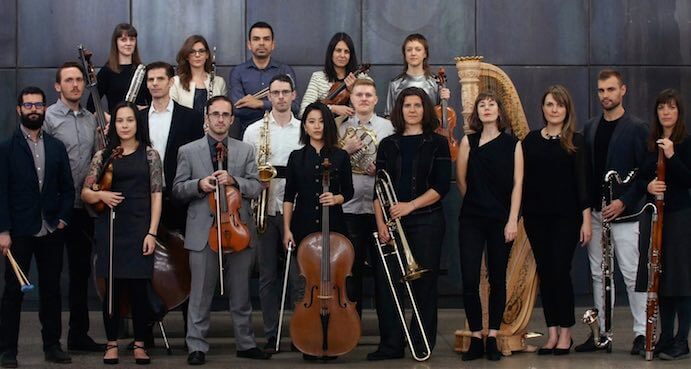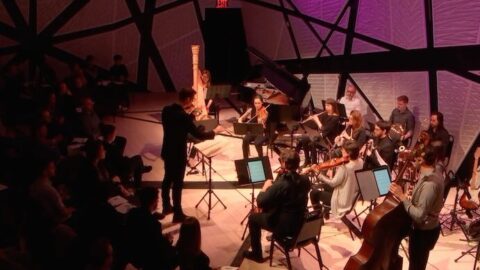You may not be familiar with Wavefield Ensemble, but if you’ve spent any amount of time attending concerts in New York City, you are definitely familiar with its members. Wavefield’s comprehensive roster unites some of the most active contemporary music all-stars who also appear with ensembles such as loadbang, TAK Ensemble, Talea Ensemble, and the International Contemporary Ensemble. Wavefield Ensemble initially formed for a performance of music by Salvatore Sciarrino at EMPAC in 2016, and then lay dormant until they relaunched last year with a full season of programs and an educational collaboration with the Rensselaer Polytechnic Institute.
On January 27th, the intimate space at National Sawdust was packed with an audience of mostly musicians and composers, with some curious others sprinkled in. The program, entitled “Visible Traces,” featured music by Matthew Ricketts (premiere of chamber version), Rebecca Saunders (US premiere), Katherine Balch (US premiere), and Iannis Xenakis. The sizeable ensemble took up over half of the floor space of the venue, so that those in the front row could easily have reached out and touched the musicians. It was refreshing to have little divide between the ensemble and audience, and to really feel immersed in the action.

The concert opened with Ricketts’ Melodia, which he describes as “an extended, digressive rumination on the basic idea of melody.” Initially conceived as a piano solo written for Julia Den Boer (who also performed with Wavefield this evening), the piece was later turned into a kind of piano concerto with orchestra, and finally reworked into the chamber version for Wavefield. This kind of writing and rewriting is a nice gloss on the theme of “visible traces;” the work is not confined to a single score, but has a life of its own across different instrumentations and timelines. The piano plays a wandering and often pale melody that floats throughout the work. Usually in just one or two voices, the modal flavors and monastic tone are reminiscent of Debussy’s Hommage à Rameau. Den Boer’s luscious and improvisatory playing was echoed by effervescent and at times prickly sounds from the ensemble, the sum total of which is a hypnotically churning and provocative exploration of melody. Ricketts’ masterful, sensitive approach to form was at the heart of Wavefield’s strongest offering.
The theme of the program, “Visible Traces,” takes its name from Saunders’ 2006 piece a visible trace. This work explores the outer extremes of the ensemble’s range, often pairing the low croaks and moans of the double bass and muted brass with softly hissing high frequencies from piccolo and violin. Short and long glissando motives bubble across the surface of the musical texture, and wobbly and wavering tones from the electric guitar and brass add an otherworldly shimmer. Saunders creates a sense of vastness in a visible trace, something akin to a large ship floating over dark, open water, where sounds of machinery echo into the void. The generally quiet textures are interrupted by outbursts: crescendi to silence, clusters on the piano, and tutti crashes.
The second half of the program opened with Balch’s Una Corda. As in Ricketts’ piece, the piano is once again the keystone of the work. A descending tetrachord figure is the focal point around which swirl cacophonous and microtonal sounds from the ensemble. The piano is prepared (small objects are inserted into the strings) so that some of its pitches have a more percussive, hollow sound than a pianistic one. Throughout the piece, at seemingly regular intervals, the percussionist tosses loose change into a jar with a charming and grounding jangle. Balch’s artfully layered orchestrations are a pleasure to explore.

The final piece, and also the oldest having been composed in 1979, was Palimpsest by Xenakis. A palimpsest is a manuscript that has been used and reused so that traces of past writing remain visible. Xenakis’s work opens with a brilliant piano solo of crisscrossing lines in a potpourri of meters. When the ensemble joins in, each instrument operates in its own timeline, with large polyrhythmic structures forming a thicket of sonic material. Despite a piercingly clear percussion part that reads as a little hokey today, the cumulative and explosive energy of this classic is undeniably thrilling.
Wavefield Ensemble is a great sounding group with a knack for dynamic programming. Nicholas DeMaison’s energetic and articulate conducting summoned an impressive palette of sounds from the ensemble, made all the more engaging through the close proximity of the audience and players. Keep an eye out for what is on the horizon for Wavefield Ensemble, which is sure to be a notable addition to the roster of New York contemporary ensembles.
























